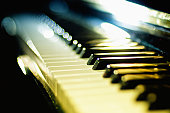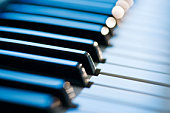
Home > Piano Tips > How the Piano Works
|
||||
How the Piano Works
Strings are one the most important components inside a piano. Every time you touch a key, 1 to 3 strings are activated and vibrate to create a sound. The strings are a specific length, diameter, density and tension to create a specific frequency. If a high-pitch sound is produced when a string vibrates fast, it most likely short, light and under a bit more tension than usual. They are made of steel and are too strong for regular wire cutters. If strings are under the wrong about of tension, the piano will sound out of tune and require some adjusting. Each string is specifically tuned by turning tuning pin, made of square sides above round shanks found in the wrest-plank or the pin-block. These turning pins are tuned by using a tuner wrench with a long handle and a square socket, while the opposite end of the string is held down with hitch-pins. In order to properly activate each string of the piano, hammers are installed. Pressing a key on your piano, activates a hammer which rises up and strikes the necessary strings. Quickly, it lies back down to avoid interfering with the vibrating strings. This function is called the escapement.
Most modern hammers are now made with strong wood covered with felt. If the felt becomes too compacted, the piano will cause an unpleasant tone. A tuner will fix this problem with specially designed needles to loosen the fibers. The soundboard is the most important elements of a piano. It amplifies the vibrations caused by the hammers and strings. Once a string is activated, the vibrations make their way a down a bridge to the soundboard. There are wooden ribs that are glued down across the bottom to help spread the vibrations caused by the strings. Cracks may form in the soundboard, however they can be easily fixed or left alone. During the dry winter months, a humidifier will help prevent cracks from forming inside the soundboard. Other important components of the piano are dampers, pedals, frame and the keyboard. The damper controls the length of the vibration, controlled by how long you hold down a note. The pedals control these dampers in order to create special effects. None of the components described would properly function without a frame. To maintain against tension and abuse, a piano must have a strong and stable frame. Studying the inner components of pianos and learning how to take care of pianos, will make you understand them and help create a lasting relationship between you and pianos.
http://pianoplayerworld.com/MikeBerealMasterClass.html
| ||||
|
Although every attempt has been made to make information as accurate as possible, we are not responsible for any errors that may appear.
 There are a few key elements inside a piano to make it function beautifully
and correctly. Components include: strings, hammers, soundboard, frame and keyboard. If you wish to
There are a few key elements inside a piano to make it function beautifully
and correctly. Components include: strings, hammers, soundboard, frame and keyboard. If you wish to 
 You will notice when one of your hammers is malfunctioning when a loud “clunk”
sound is produced. The hammer is unable to drop back down and interferes with strings. The size of each hammer
increases, as the piano increases from treble to bass.
You will notice when one of your hammers is malfunctioning when a loud “clunk”
sound is produced. The hammer is unable to drop back down and interferes with strings. The size of each hammer
increases, as the piano increases from treble to bass.



